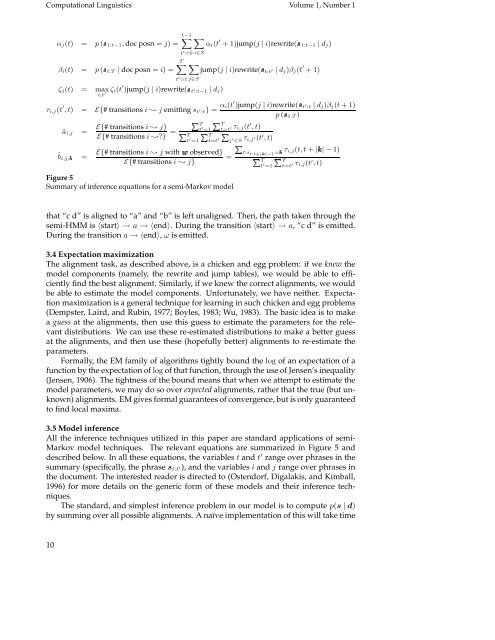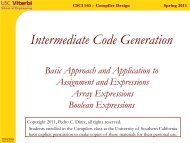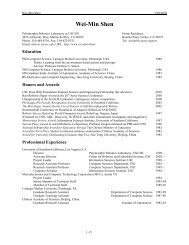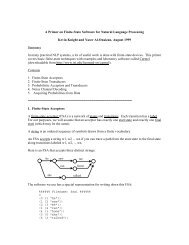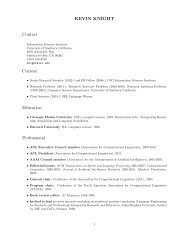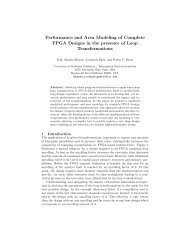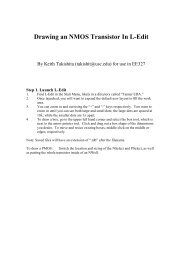Induction of Word and Phrase Alignments for Automatic Document ...
Induction of Word and Phrase Alignments for Automatic Document ...
Induction of Word and Phrase Alignments for Automatic Document ...
Create successful ePaper yourself
Turn your PDF publications into a flip-book with our unique Google optimized e-Paper software.
Computational Linguistics Volume 1, Number 1<br />
αj(t) = p ( 1:t−1, doc posn = j) =<br />
βi(t) = p ( t:T | doc posn = i) =<br />
¡ ¡ t−1<br />
αi(t<br />
t ′ =0 i∈S<br />
′ + 1)jump(j | i)rewrite( 1:t−1 | dj)<br />
¡ ¡ T<br />
t ′ =t j∈S<br />
ζj(t) = max<br />
i,t ′ ζi(t′ )jump(j | i)rewrite( t ′ :t−1 | dj)<br />
jump(j | i)rewrite( t:t ′ | dj)βj(t ′ + 1)<br />
τi,j(t ′ , t) = E{# transitions i ❀ j emitting st ′ :t} = αi(t′ )jump(j | i)rewrite( t ′ :t | dj)βj(t + 1)<br />
p ( 1:T )<br />
âi,j =<br />
ˆ bi,j,£ =<br />
E{# transitions i ❀ j}<br />
E{# transitions i ❀?}<br />
¢ = T<br />
¢<br />
t ′ =1¢<br />
E{# transitions i ❀ j with¤ observed}<br />
E{# transitions i ❀ j}<br />
Figure 5<br />
Summary <strong>of</strong> inference equations <strong>for</strong> a semi-Markov model<br />
T<br />
t ′ T<br />
t=t =1¢<br />
′ τi,j(t′ , t)<br />
T<br />
t=t ′ j ¢ ′ ∈S τi,j ′(t′ , t)<br />
= ¢ t:s t:t+|k|−1 =£<br />
¢<br />
T<br />
t ′ =1¢<br />
τi,j(t, t + |¥ | − 1)<br />
T<br />
t=t ′ τi,j(t′ , t)<br />
that “c d” is aligned to “a” <strong>and</strong> “b” is left unaligned. Then, the path taken through the<br />
semi-HMM is 〈start〉 → a → 〈end〉. During the transition 〈start〉 → a, “c d” is emitted.<br />
During the transition a → 〈end〉, ω is emitted.<br />
3.4 Expectation maximization<br />
The alignment task, as described above, is a chicken <strong>and</strong> egg problem: if we knew the<br />
model components (namely, the rewrite <strong>and</strong> jump tables), we would be able to efficiently<br />
find the best alignment. Similarly, if we knew the correct alignments, we would<br />
be able to estimate the model components. Un<strong>for</strong>tunately, we have neither. Expectation<br />
maximization is a general technique <strong>for</strong> learning in such chicken <strong>and</strong> egg problems<br />
(Dempster, Laird, <strong>and</strong> Rubin, 1977; Boyles, 1983; Wu, 1983). The basic idea is to make<br />
a guess at the alignments, then use this guess to estimate the parameters <strong>for</strong> the relevant<br />
distributions. We can use these re-estimated distributions to make a better guess<br />
at the alignments, <strong>and</strong> then use these (hopefully better) alignments to re-estimate the<br />
parameters.<br />
Formally, the EM family <strong>of</strong> algorithms tightly bound the log <strong>of</strong> an expectation <strong>of</strong> a<br />
function by the expectation <strong>of</strong> log <strong>of</strong> that function, through the use <strong>of</strong> Jensen’s inequality<br />
(Jensen, 1906). The tightness <strong>of</strong> the bound means that when we attempt to estimate the<br />
model parameters, we may do so over expected alignments, rather that the true (but unknown)<br />
alignments. EM gives <strong>for</strong>mal guarantees <strong>of</strong> convergence, but is only guaranteed<br />
to find local maxima.<br />
3.5 Model inference<br />
All the inference techniques utilized in this paper are st<strong>and</strong>ard applications <strong>of</strong> semi-<br />
Markov model techniques. The relevant equations are summarized in Figure 5 <strong>and</strong><br />
described below. In all these equations, the variables t <strong>and</strong> t ′ range over phrases in the<br />
summary (specifically, the phrase st:t ′), <strong>and</strong> the variables i <strong>and</strong> j range over phrases in<br />
the document. The interested reader is directed to (Ostendorf, Digalakis, <strong>and</strong> Kimball,<br />
1996) <strong>for</strong> more details on the generic <strong>for</strong>m <strong>of</strong> these models <strong>and</strong> their inference techniques.<br />
The st<strong>and</strong>ard, <strong>and</strong> simplest inference problem in our model is to compute p(s | d)<br />
by summing over all possible alignments. A naïve implementation <strong>of</strong> this will take time<br />
10


